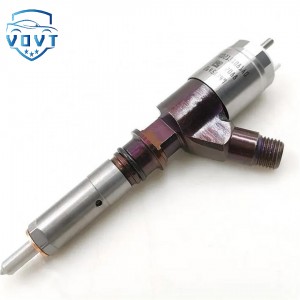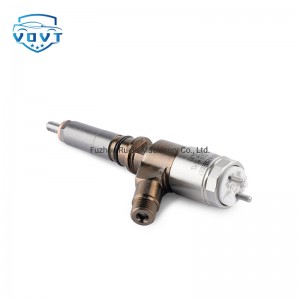New High Quality Diesel Injector 7E-2269 7E-3381 0R-3051 7E-3382 0R-2921 7E-3383 0R-2925 For CAT 3500A
Products Description
| Reference. Codes | 3500A |
| Application | 3500A |
| MOQ | 4PCS |
| Certification | ISO9001 |
| Place of Origin | China |
| Packaging | Neutral packing |
| Quality Control | 100% tested before shipment |
| Lead time | 7~10 working days |
| Payment | T/T, L/C, Paypal, Western Union, MoneyGram or as your requirement |
Introduction to diesel fuel injectors
Structure and working principle
1. Typical structure
The diesel fuel injector is mainly composed of the following components:
Fuel injector body: There is a fuel channel processed internally, connected to a high-pressure common rail pipe or fuel injection pump.
Needle valve assembly:
Needle valve: Pushed by oil pressure to open/close the spray hole to control fuel injection.
Needle valve body: There is a spray hole (hole nozzle) at the lower end, and the inner wall forms a precision pairing with the needle valve (matching gap 0.002-0.004mm), requiring extremely high processing accuracy.
Pressure control mechanism:
Solenoid valve (electro-controlled fuel injector): receives ECU signal, quickly open and close through electromagnetic force, and controls the fuel injection time and pulse width.
Pressure regulating spring: Traditional mechanical fuel injectors set the opening pressure through spring preload.
Oil return device: Excess fuel returns to the oil tank through the return pipe to maintain the internal oil pressure stable.
2. Working principle
Oil suction stage: Fuel oil enters the injector body through the common rail pipe through the oil inlet hole, filling the upper oil chamber of the needle valve.
Jet phase:
Electronically controlled fuel injector: The ECU triggers the solenoid valve to be turned on, the armature is moved upward to open the oil return hole, the oil pressure in the upper part of the needle valve drops, the needle valve is lifted under the action of the fuel pressure at the lower part, and the fuel is sprayed out from the injection hole.
Mechanical fuel injector: When the fuel pressure exceeds the preload force of the pressure regulating spring, directly push the needle valve to inject.
Closed stage: The solenoid valve is powered off or the fuel pressure drops, the needle valve is reset under the action of spring force or upper oil pressure, and the fuel injection is stopped.
Core performance requirements
1. High pressure jet capability
Pressure level: The pressure of modern common rail injectors can reach 200-300MPa (in the future development towards 500MPa), and high pressure can refine fuel particles (particle size < 10μm) to improve combustion efficiency.
Pressure stability: Maintain injection pressure fluctuations of ≤5% under different working conditions (such as idle speed, full load) to avoid uneven atomization.
2. Accurate measurement and response
Oil injection volume control accuracy: single injection volume error ≤±1%, small oil volume (such as idle speed) control error ≤±0.5mm³/cycle.
Response speed: The solenoid valve opening/closing time must be within 1-3ms to meet multiple injection needs (such as a combination of pre-spray + main injection + rear injection).
3. Optimization of spray characteristics
Spray cone angle: Design the spray hole angle according to the shape of the combustion chamber (such as ω type, bowl type) to ensure that the oil beam covers the entire combustion area.
Throughout distance: The high-pressure oil beam needs to penetrate compressed air (diesel engine compression ratio 15-22:1) to avoid fuel adhering to the cylinder wall and causing wet wall effect and carbon soot generation.
4. Reliability and durability
Anti-wear: The needle valve and the needle valve body must ensure a life of ≥300,000 kilometers under the erosion of high-pressure fuel (including fine impurities) (diesel engines for automobiles), and the materials need to be nitrided and plating (such as silicon nitride ceramics, diamond coatings).
Sealing: Prevent fuel leakage at high temperature (combustion chamber temperature can reach 1800-2200K) and high pressure. The sealing ring is made of fluoroelastic or metal sealing ring.
Frequently Asked Questions and Faults
1. Blockage
Cause: Fuel oil contains impurities (such as sulfur, moisture, mechanical particles), additive deposition or high temperature coking.
Impact: Reduced fuel injection volume and poor atomization, resulting in reduced power and excessive emissions (increased PM).
Solution: Install high-precision fuel filter (filtration accuracy ≤5μm), and use low-sulfur diesel (sulfur content ≤10ppm).
2. Leakage
Cause: Wear of needle valve, scratched sealing surface or aging of solenoid valve seals.
Impact: Unstable idle speed, difficulty in starting (fuel diluted engine oil), and in severe cases, abnormal combustion or fire risk.
Solution: Clean the fuel injector regularly, replace the wear pairs, and adopt wear-resistant coatings (such as diamond-like coating DLC).
3. Insufficient injection pressure
Cause: Common rail pipe leak, oil pump wear or solenoid valve stagnation.
Impact: Poor fuel penetration, locally too thick for the mixture, resulting in black smoke and increased fuel consumption.
Solution: Detect common rail pressure sensor, replace damaged parts, and calibrate the fuel injector opening pressure.
Development trends
1. Higher pressure and intelligence
Ultra-high pressure common rail technology: pressure exceeds 300MPa, combined with nano-scale nozzle holes (pore size < 0.1mm), more subtle atomization is achieved.
Intelligent control: Integrated pressure sensor and temperature sensor, real-time feedback of the injector status, and dynamically correct the injection volume of the ECU (such as Bosch third-generation common rail system CR3).
2. New materials and processes
Ceramic components: The needle valve uses silicon nitride (Si₃N₄) ceramic, with high hardness (HV1500), wear resistance, and a life span of more than 3 times.
3D printing technology: Making complex internal runners by laser molten metal powders such as Inconel alloys to optimize fuel flow characteristics.
3. Diversified fuel adaptation
Biodiesel and alternative fuels: adapt to high viscosity fuels (such as palm oil methyl ester), optimize the spray hole structure to prevent coking.
Hydrogen fuel injection: Develop a high-pressure hydrogen injector (pressure ≥70MPa) for direct injecting in the cylinder of hydrogen fuel internal combustion engines.
4. Low emissions and energy saving
Multiple injection strategy: Pre-injection reduces combustion noise, post-injection promotes soot oxidation, and reduces NOx emissions in combination with EGR (exhaust gas recirculation) system.
Thermal management optimization: The injector integrates cooling channels to avoid fuel vaporization (cavitation phenomenon) caused by high temperatures and improve fuel metering accuracy.
Diesel fuel injectors are the "heart" of diesel engines, and their technological evolution has always revolved around the three cores of precision control, high-pressure atomization, and reliability and durability. In the future, with the promotion of carbon emission reduction policies, fuel injectors will be more deeply integrated with intelligence, new materials and alternative fuel technologies, not only serving the efficiency improvement of traditional diesel engines, but also expanding application scenarios in new power systems such as hydrogen energy and synthetic fuels.























